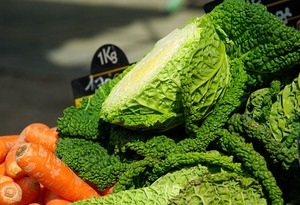Nutritional Breakdown of Cabbage Detox Soup
Understanding the nutritional breakdown of cabbage and vegetable detox soup is vital to optimizing its use in your diet. Cabbage detox soup is known for being nutrient-dense yet low in calories, making it ideal for those looking to detox or lose weight without sacrificing essential nutrients. The table below highlights the key nutritional components per serving, helping you tailor this soup to your specific dietary needs, whether you’re on a detox, a weight-loss journey, or simply aiming for healthier eating habits.
| Nutrient | Amount per Serving |
|---|---|
| Calories | 50-100 kcal |
| Protein | 1-3 grams |
| Carbohydrates | 8-12 grams |
| Fat | 1-2 grams |
| Fiber | 3-5 grams |
| Vitamin C | 30-50% DV |
| Vitamin K | 70-90% DV |
| Potassium | 5-10% DV |
Explanation of Nutritional Components:
- Calories: Each serving of cabbage and vegetable detox soup contains approximately 50 to 100 calories, making it a light meal perfect for those following a calorie-controlled diet.
- Protein: With 1 to 3 grams of protein per serving, the soup is not protein-dense but can be enhanced by adding ingredients like beans, lentils, or tofu for a more complete meal.
- Carbohydrates: The soup contains 8 to 12 grams of complex carbohydrates from vegetables like carrots, celery, and cabbage. These provide a steady source of energy while keeping you full longer.
- Fat: Cabbage detox soup is naturally low in fat, with only 1 to 2 grams of healthy fats (primarily from olive oil or optional add-ons). Adding a small amount of healthy fats, like olive oil, enhances the absorption of fat-soluble vitamins.
- Fiber: High fiber content (around 3-5 grams per serving) supports digestion, promotes satiety, and aids in detoxification by helping to eliminate waste from the body.
- Vitamin C and K: These vitamins are abundant in cabbage and other vegetables used in the soup. Vitamin C is essential for immune function and skin health, while Vitamin K supports bone health and proper blood clotting.
- Potassium: Cabbage, carrots, and celery contribute 5-10% of your daily potassium needs, helping maintain proper fluid balance, muscle function, and heart health.
Tips for Using Cabbage Detox Soup

Incorporating cabbage and vegetable detox soup into your daily routine can significantly enhance its detoxifying and nutritional benefits. Here are some expert tips for using this soup to maximize its effectiveness, whether you’re using it as part of a detox cleanse or simply as a nutritious, low-calorie meal.
| Tip | Description |
|---|---|
| Consume with Hydration | Drink plenty of water alongside the soup to aid in detoxification and help flush out toxins. |
| Add Protein for a Complete Meal | Boost the protein content by adding lentils, beans, or shredded chicken for a more balanced and satisfying meal. |
| Pair with Fresh Veggies | Serve with a side salad of raw vegetables to increase fiber intake and add extra crunch and nutrients. |
| Use Fresh Herbs for Flavor | Fresh herbs like parsley, cilantro, or dill can enhance the flavor and nutrient profile without adding extra calories. |
| Prepare in Bulk | Make a large batch of the soup and freeze it in individual portions to have detox meals ready to go throughout the week. |
How to Maximize These Tips:
- Hydration: Detox soups work best when you’re properly hydrated. Make sure to drink at least 8 glasses of water per day while consuming cabbage detox soup. This helps the kidneys function optimally, flushing out toxins.
- Add Protein: While the soup is already nutrient-dense, adding protein sources like beans or tofu can make it more filling and turn it into a complete meal, especially for those on a more extended detox or cleanse.
- Fresh Veggies: Pairing the soup with a side salad or a plate of raw vegetables provides extra fiber and vitamins, which further supports the detox process. Consider adding sliced cucumbers, tomatoes, or bell peppers as a fresh complement.
- Herbs and Flavor Enhancers: To avoid flavor fatigue during a cleanse, experiment with different fresh herbs and seasonings. Herbs like cilantro or parsley not only enhance flavor but also provide additional detoxifying properties.
- Spices for Extra Benefits: Adding spices like turmeric boosts the anti-inflammatory and antioxidant properties of the soup, supporting overall liver health. Ginger is known for its digestive benefits and can help soothe the stomach, reducing bloating. Cayenne pepper can help stimulate metabolism and improve circulation, aiding the detox process. Garlic is another excellent addition, known for its antibacterial and immune-boosting properties. Cinnamon can balance blood sugar levels, which is beneficial during a cleanse.
- Batch Cooking: By preparing in bulk and freezing portions, you’ll have a convenient detox option available whenever you need it. This is especially useful for busy individuals who may not have time to prepare fresh meals every day.

Best Times to Consume Cabbage Detox Soup
When you eat detox soup can be just as important as what’s in it. The cabbage and vegetable detox soup is versatile and can be enjoyed at various times depending on your health goals. This table outlines the best times to consume the soup to ensure you reap its full detoxifying benefits.
| Best Time | Why |
|---|---|
| During a Cleanse | Helps reset your body and promotes detoxification over a 3-7 day cleanse period. |
| Post-Holiday or After Heavy Meals | Alleviates bloating and supports digestion after consuming rich, calorie-dense foods. |
| As a Light Dinner | The soup is light yet nourishing, making it perfect for a low-calorie evening meal that’s easy to digest. |
| After Workouts | Provides a nutrient boost without overloading your digestive system post-exercise. |
| For Midday Energy Boost | A healthy alternative to heavier lunches, giving you a light, energy-boosting meal option. |
Timing for Maximum Detox Results:
- During a Cleanse: Many people follow 3, 5, or 7-day detox cleanses where they consume cabbage soup 2-3 times a day to aid digestion and give their body a break from processed foods. This is a great way to reset the digestive system while consuming essential nutrients.
- Post-Holiday: After periods of indulgence (like holidays or weekends with heavy meals), this soup works wonders to reduce bloating and promote digestion. The high water content helps flush out excess salt and toxins from rich meals.
- Light Dinner: Cabbage detox soup is ideal for dinner, especially if you’re looking for a light, nutritious option that won’t sit heavily in your stomach overnight. It’s low in calories but filling enough to curb late-night snacking.
- After Workouts: Eating this soup post-workout ensures that your body gets the vitamins and minerals needed to recover without adding excess calories or fats.
- Midday Boost: As a low-calorie but nutrient-dense option, this soup is perfect for a midday meal. It gives you sustained energy without the afternoon slump caused by heavier lunches.
Notes for Optimizing the Benefits of Detox Soup
For best results, it’s important to follow certain guidelines when consuming cabbage and vegetable detox soup. Below are key notes that will help you optimize the benefits of this detox soup, whether you’re using it as part of a cleanse or as a regular meal in your diet.
| Note | Details |
|---|---|
| Avoid Processed Foods During Detox | For best results, avoid processed sugars, refined carbs, and alcohol while detoxing. |
| Listen to Your Body | If you feel fatigued or unwell, ensure you’re consuming enough calories and nutrients. |
| Add Healthy Fats | A drizzle of olive oil or avocado can improve nutrient absorption without adding too many calories. |
| Monitor Portion Sizes | Though healthy, consuming large portions could still contribute to caloric intake. |
| Consult a Doctor Before Prolonged Cleanses | If planning to detox for more than a week, consult a healthcare provider. |

